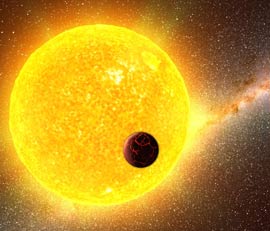A magazine where the digital world meets the real world.
On the web
- Home
- Browse by date
- Browse by topic
- Enter the maze
- Follow our blog
- Follow us on Twitter
- Resources for teachers
- Subscribe
In print
What is cs4fn?
- About us
- Contact us
- Partners
- Privacy and cookies
- Copyright and contributions
- Links to other fun sites
- Complete our questionnaire, give us feedback
Search:
Listen to the stars sing

Listening to stars sing doesn't have to mean listening to the latest talent show. The stars in the night sky sing too!
When you think of astronomy you probably think of the people looking into telescopes, beautiful images of distant crab nebula, or maybe the stunning pictures of Saturn's rings taken by probes sent to explore them. Maybe if you are a real enthusiast you will have recently been up at dawn hoping for a break in the clouds to catch a glimpse of the transit of Venus. Astronomy isn't all about what we can see though. Surprisingly stars make a lot of noise, and the Kepler spacecraft has recorded the sounds from over 500 sun-like stars so far. Even more surprisingly perhaps, it turns out you can weigh stars based on the sounds they make!
The movement inside a star makes them vibrate like a musical instrument and so make sounds. As Bill Chaplin from the University of Birmingham's School of Physics and Astronomy, who leads the international collaboration doing the research explains: "If you measure the pitch of the notes produced by an instrument it can tell you how big the instrument is. The bigger the instrument is, the lower the pitch and deeper the sound." A big double bass makes a deeper sound than a cello which in turn is deeper than the much smaller violin. Similarly a big star will make music with a deeper pitch than a small one.
As one of the scientists involved, Graham Verner of Queen Mary, University of London notes, being able to weigh stars by listening to their songs is exciting because it means we can create a much more accurate picture of the stars in our galaxy. If only they could sing in tune though!
For a BBC news video which includes the sounds of stars see www.bbc.co.uk/news/science-environment-13009718


